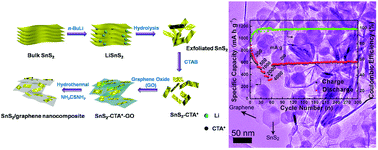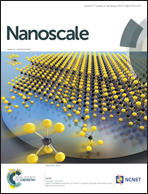Exfoliated-SnS2 restacked on graphene as a high-capacity, high-rate, and long-cycle life anode for sodium ion batteries†
Abstract
Designed as a high-capacity, high-rate, and long-cycle life anode for sodium ion batteries, exfoliated-SnS2 restacked on graphene is prepared by the hydrolysis of lithiated SnS2 followed by a facile hydrothermal method. Structural and morphological characterizations demonstrate that ultrasmall SnS2 nanoplates (with a typical size of 20–50 nm) composed of 2–5 layers are homogeneously decorated on the surface of graphene, while the hybrid structure self-assembles into a three-dimensional (3D) network architecture. The obtained SnS2/graphene nanocomposite delivers a remarkable capacity as high as 650 mA h g−1 at a current density of 200 mA g−1. More impressively, the capacity can reach 326 mA h g−1 even at 4000 mA g−1 and remains stable at ∼610 mA h g−1 without fading up to 300 cycles when the rate is brought back to 200 mA g−1. The excellent electrochemical performance is attributed to the synergetic effects between the ultrasmall SnS2 and the highly conductive graphene network. The unique structure can simultaneously facilitate Na+ ion diffusion, provide more reaction sites, and suppress aggregation and volume fluctuation of the active materials during prolonged cycling.


 Please wait while we load your content...
Please wait while we load your content...